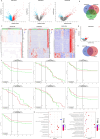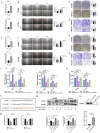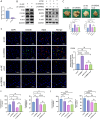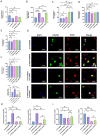miR-455/GREM1 axis promotes colorectal cancer progression and liver metastasis by affecting PI3K/AKT pathway and inducing M2 macrophage polarization
- PMID: 38970064
- PMCID: PMC11225248
- DOI: 10.1186/s12935-024-03422-1
miR-455/GREM1 axis promotes colorectal cancer progression and liver metastasis by affecting PI3K/AKT pathway and inducing M2 macrophage polarization
Abstract
Background: Colorectal cancer is among the most common malignant tumors affecting the gastrointestinal tract. Liver metastases, a complication present in approximately 50% of colorectal cancer patients, are a considerable concern. Recently, studies have revealed the crucial role of miR-455 in tumor pathogenesis. However, the effect of miR-455 on the progression of liver metastases in colorectal cancer remains controversial. As an antagonist of bone morphogenetic protein(BMP), Gremlin 1 (GREM1) may impact organogenesis, body patterning, and tissue differentiation. Nevertheless, the role of miR-455 in regulating GREM1 in colorectal cancer liver metastases and how miR-455/GREM1 axis influences tumour immune microenvironment is unclear.
Methods: Bioinformatics analysis shows that miR-455/GREM1 axis plays crucial role in liver metastasis of intestinal cancer and predicts its possible mechanism. To investigate the impact of miR-455/GREM1 axis on the proliferation, invasion, and migration of colorectal cancer cells, colony formation assay, wound healing and transwell assay were examined in vitro. The Dual-Luciferase reporter gene assay and RNA pull-down assay confirmed a possible regulatory effect between miR-455 and GREM1. In vivo, colorectal cancer liver metastasis(CRLM) model mice was established to inquiry the effect of miR-455/GREM1 axis on tumor growth and macrophage polarization. The marker of macrophage polarization was tested using immunofluorescence(IF) and quantitative real-time polymerase chain reaction(qRT-PCR). By enzyme-linked immunosorbent assay (ELISA), cytokines were detected in culture medium supernatants.
Results: We found that miR-455 and BMP6 expression was increased and GREM1 expression was decreased in liver metastase compared with primary tumor. miR-455/GREM1 axis promotes colorectal cancer cells proliferation, migration, invasion via affected PI3K/AKT pathway. Moreover, downregulating GREM1 augmented BMP6 expression in MC38 cell lines, inducing M2 polarization of macrophages, and promoting liver metastasis growth in CRLM model mice.
Conclusion: These data suggest that miR-455/GREM1 axis promotes colorectal cancer progression and liver metastasis by affecting PI3K/AKT pathway and inducing M2 macrophage polarization. These results offer valuable insights and direction for future research and treatment of CRLM.
Keywords: AKT; Colorectal cancer; GREM1; Liver metastasis; Macrophage polarization; PI3K; miR-455.
© 2024. The Author(s).
Conflict of interest statement
The authors declare no competing interests.
Figures







Similar articles
-
miR-122/NEGR1 axis contributes colorectal cancer liver metastasis by PI3K/AKT pathway and macrophage modulation.J Transl Med. 2024 Nov 25;22(1):1060. doi: 10.1186/s12967-024-05901-5. J Transl Med. 2024. PMID: 39587606 Free PMC article.
-
Orosomucoid 1 promotes colorectal cancer progression and liver metastasis by affecting PI3K/AKT pathway and inducing macrophage M2 polarization.Sci Rep. 2023 Aug 28;13(1):14092. doi: 10.1038/s41598-023-40404-1. Sci Rep. 2023. PMID: 37640741 Free PMC article.
-
Tumor-derived exosomal miR-934 induces macrophage M2 polarization to promote liver metastasis of colorectal cancer.J Hematol Oncol. 2020 Nov 19;13(1):156. doi: 10.1186/s13045-020-00991-2. J Hematol Oncol. 2020. PMID: 33213490 Free PMC article.
-
New insights into Gremlin-1: A tumour microenvironment landscape re-engineer and potential therapeutic target.Biochim Biophys Acta Mol Cell Res. 2025 Jun;1872(5):119962. doi: 10.1016/j.bbamcr.2025.119962. Epub 2025 Apr 16. Biochim Biophys Acta Mol Cell Res. 2025. PMID: 40250712 Review.
-
Gremlin1: a BMP antagonist with therapeutic potential in Oncology.Invest New Drugs. 2024 Dec;42(6):716-727. doi: 10.1007/s10637-024-01474-8. Epub 2024 Sep 30. Invest New Drugs. 2024. PMID: 39347850 Review.
Cited by
-
Knockdown of miR-411-3p induces M2 macrophage polarization and promotes colorectal cancer progression by regulation of MMP7.Eur J Histochem. 2025 Apr 7;69(2):4178. doi: 10.4081/ejh.2025.4178. Epub 2025 May 5. Eur J Histochem. 2025. PMID: 40322788 Free PMC article.
-
Tumour-derived exosomal miR-205 promotes ovarian cancer cell progression through M2 macrophage polarization via the PI3K/Akt/mTOR pathway.J Ovarian Res. 2025 Feb 15;18(1):28. doi: 10.1186/s13048-025-01616-3. J Ovarian Res. 2025. PMID: 39955607 Free PMC article.
-
Human umbilical cord mesenchymal stem cells ameliorate liver fibrosis by inhibiting hepatocyte ferroptosis and macrophage polarization via the miR-455-3p/PLAU axis.Stem Cell Res Ther. 2025 Jul 30;16(1):412. doi: 10.1186/s13287-025-04526-9. Stem Cell Res Ther. 2025. PMID: 40739265 Free PMC article.
-
A comprehensive prognostic and immunological implications of Gremlin 1 in lung adenocarcinoma.Front Immunol. 2025 Feb 24;16:1529195. doi: 10.3389/fimmu.2025.1529195. eCollection 2025. Front Immunol. 2025. PMID: 40066442 Free PMC article.
-
The Role of GREMLIN1, a Bone Morphogenetic Protein Antagonist, in Cancer Stem Cell Regulation.Cells. 2025 Apr 11;14(8):578. doi: 10.3390/cells14080578. Cells. 2025. PMID: 40277903 Free PMC article. Review.
References
-
- Siegel RL, Wagle NS, Cercek A, Smith RA, Jemal A. Colorectal cancer statistics, 2023. CA Cancer J Clin. 2023. - PubMed
LinkOut - more resources
Full Text Sources
Research Materials
Miscellaneous

